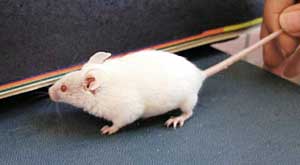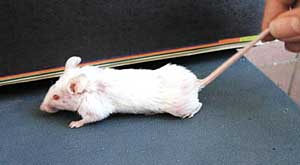How to Confine the Plants of the Future?
By Denise Caruso
New York Times
April 08, 2007
A new generation of genetically engineered crops that produce drugs and chemicals is fast approaching the market — bringing with it a new wave of concerns about the safety of the global food and feed supply.
The plants produce medicinal substances like insulin, anticoagulants and blood substitutes. They produce vaccine proteins for diseases like cholera, as well as antibodies against tooth decay and non-Hodgkin’s lymphoma. Enzymes and other chemicals from the plants can be used for a range of industrial processes.
As in past debates over genetically modified crops, biotech developers say that the benefits outweigh the risks, and that the risks are manageable. Critics question the benefits, and say the risk of a contaminated and potentially toxic food supply is untenable.
In the middle, balancing economic benefit and public safety, are our appointed arbiters of risk, the government regulators.
Controversies over biotech risk are caused by a crisis in “official scientific expertise,” according to Jerome Ravetz, an associate fellow at the James Martin Institute for Science and Civilization at the University of Oxford.
The crisis, he said, stems from the conflicting roles of government. On one side, businesses provide regulators with scientific evidence about the risk and safety of their product innovations. On the other, suspicious citizens demand that regulators challenge that evidence.
The side whose expertise is accepted as “official” calls the shots.
So far, the business sector has tipped the scales in its favor. Despite science-based concerns voiced by farmers, environmentalists and even its own researchers, the United States Department of Agriculture has approved more than 100 applications to grow so-called biopharma crops of corn, soybeans, barley, rice, safflower and tobacco in the United States.
Developers say these crops are the best way to achieve the economies of scale and cost savings that will let them meet rising demand for drugs like human insulin.
They acknowledge that growing pharmaceutical crops is riskier than making drugs in factories. They know that the plants contain potentially toxic drugs and chemicals, and because they look like ordinary crops, they can be mistaken for food, both before and after harvest.
The most important thing, then, is to keep biopharma plants, pollen and seeds confined to the fields where they are planted. Otherwise, they may contaminate other crops, wild relatives and the environment.
Developers say they have worked with the Agriculture Department to develop containment procedures for biopharma crops.
“Under our system, the degree of oversight is commensurate with the risk of the crops,” said John Turner, director of the policy coordination program for the agency’s Biotechnology Regulatory Services. “We take extraordinary measures to make sure these pharma and industrial crops are kept separate and confined.”
To this end, some developers use plants like rice and safflower that self-pollinate, reducing the risk of contaminating nonpharma plants by wind and insect pollination.
They also provide regulators with data on the potential health and environmental effects of the special chemicals in their crops.
For example, SemBioSys, a Canadian company, has applied to the U.S.D.A. for permits to grow safflower-based human insulin. It is already field-testing safflower crops in the United States and Chile that produce carp growth hormone for aquaculture feed, to bolster the weak immune systems of farmed shrimp.
The company’s chief executive, Andrew Baum, says “categorically” that the insulin derived from its plants has no biological effects while in plant form, and is activated only after processing. And the evidence his company has gathered indicates that its carp growth hormone affects only shrimp.
The new methods, Mr. Baum said, can cut capital costs by 70 percent, and “reach levels of scale easier than any other system.”
But there is some scientific evidence not acknowledged in biopharma risk assessments that casts a dark cloud over this silver lining.
For starters, the “system” under discussion is nature, and despite our best efforts it always manages to elude our puny attempts at controlling it. The containment practices used by developers assume an ability to control living and propagating organisms, which scientific evidence does not support.
One scientist familiar with some of the issues raised by pharma crops is Norman C. Ellstrand, a professor in the department of genetics at the University of California, Riverside, and director of its Biotechnology Impacts Center. Professor Ellstrand is known as a fair and credible critic of various aspects of agricultural biotechnology.
He is deeply skeptical that efforts to confine biopharma genes in open fields will work.
“I don’t think that engineering plants for pharma is a bad idea, with two caveats,” Professor Ellstrand said. One, he says he thinks that planting should be done in greenhouses rather than in open fields. “The other issue is food,” he said. “Why do we have to do this in food crops? It doesn’t matter what you’re squeezing the compound out of. It could be a carnation, a corn plant or a castor bean.”
Professor Ellstrand also said that self-pollination does not eliminate gene flow between plants, and that cross-pollination is not the only way that pharma crops can escape confinement. Once harvested, seeds can move easily, accidentally or deliberately, across and beyond borders. As a result, valuable biopharma crops may well end up growing in fields far from the controlled environment on which developers depend for safety. And what happens from there is anyone’s guess.
Once the rogue seeds are replanted, could the plants thrive in their new home and possibly overtake native varieties or wild relatives? Could the pharma trait increase in frequency and concentration, until it reaches a “dose” that causes health effects in those who consume it unwittingly? The probability for any one of these situations may be low, Professor Ellstrand said, but the scientific answer to each question is yes.
What is most worrisome is that the Agriculture Department seems to reject such reasonable, science-based public safety concerns. Agency policy allows developers to withhold data on pharma crops from the public as confidential business information, and the public is not allowed to comment on biopharma planting applications until after an official risk evaluation is completed.
Such behavior has raised the hackles of many farmers and food producers who are concerned about biopharma crops. Rice farmers, in particular, know what happens when a food crop is contaminated with unapproved genes. The U.S.D.A has presided over two such scares in less than a year, and the rice industry has suffered greatly as it tries to purge contaminants from crops.
AT the end of March, the Agriculture Department approved a permit allowing a California biotech company, Ventria Bioscience, to plant its pharmaceutical rice in open fields in Kansas.
Ventria’s pharma rice is engineered to produce two of the human proteins found in breast milk and other body fluids. Once harvested, the proteins will be used in treatments for diarrhea and infections, as well as in nutritional supplements.
In a public comment demanding that the Agriculture Department withdraw the Ventria approval, the U.S.A. Rice Federation wrote: “If Ventria’s pharmaceutical rice were to escape into the commercial rice supply, the financial devastation to the U.S. rice industry would likely be absolute. There is no tolerance, either regulatory or in public perception, for a human gene-based pharmaceutical to end up in the world’s food supply.”
So whose market is more important: the farmers’ or the drug makers’? Whose health matters more: people who need drugs or people who eat food?
Scientists often dismiss the idea that people without technical knowledge can help them make risk assessments. As a result, biotech scientists and regulators have long made safety determinations from within an opaque system of their own design, using only the evidence they accept as valid.
But scientific evidence is not a constant, like the speed of light or pi. Especially in biology, where we still know so little, “evidence” is often just a small circle of light surrounded by the darkness of the unknown. Decisions about risk cannot safely be made in a private club that accepts only its members’ notions of scientific evidence.
The best research on risk declares the opposite to be true: that risk evidence is particularly subject to distortion by conflicting interests, and that the best foil for such distortions is to ensure that the people whose fate is at stake participate in the analysis.
We need a new policy framework for scientific evidence that is built on this foundation. If developers want to sell their products, they must subject their inventions to the helpful scrutiny of people outside the club — before radical technologies like biopharma are brought to market.



